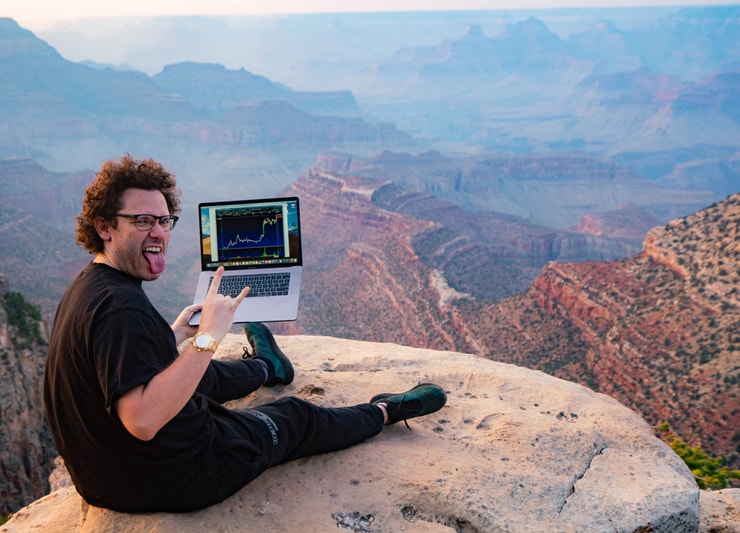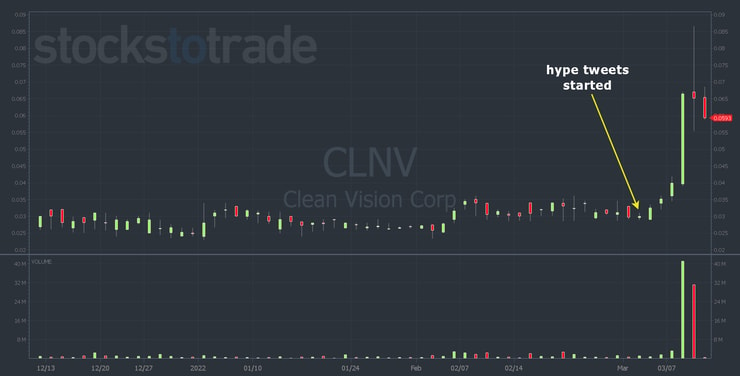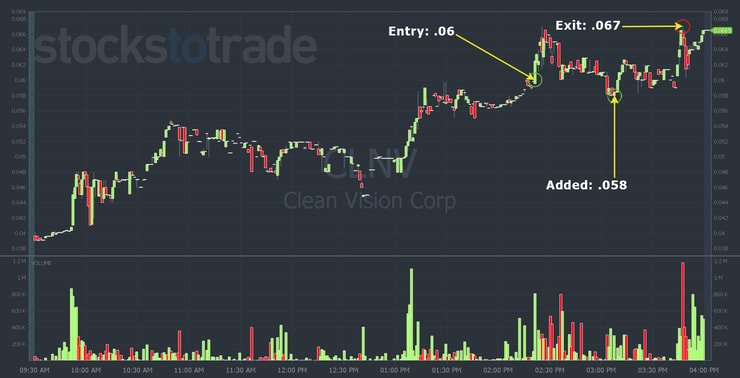You might not know this, but I go into every trade with a plan. A trading plan is a key part of the process.
Usually when I review trades, it’s about sticking to the plan. Along with this question…
“What Broker Should I Be Using?”
One of the most frequently asked questions I get is…
“How do you know when to alter the plan?”
Sometimes you have to adapt during a trade.
That’s exactly what happened on March 8 when I traded Clean Vision Corp. (OTCQB: CLNV).
In this trade review, I’ll explain my thought process during the trade. Check it out…
Table of Contents
Another Perfect OTC First Green Day Play

On Tuesday, CLNV was a perfect OTC first green day.
What do I mean? This is what I look for…
- A big percent gain — usually a morning spike.
- Higher than average volume.
- A news catalyst. (Keep reading, because the catalyst was comical.) And…
- The stock is at or near its highs going into the close.
That’s the basic setup.
First, check out the CLNV intraday chart from March 8…

Inside the Thought Process of a Day Trader
As you can see, CLNV had a morning spike and then consolidated. Around 1 p.m. Eastern, it hit new highs.
By then I was already interested. Why?
It was a big percent gainer — that always gets my attention.
I looked for news, but there wasn’t a press release. So, I used the StocksToTrade social media search tool to see if there was any chatter. Sure enough, the company had been tweeting about a new facility in India since March 2.
You can see where it started on the three-month chart…

With a constant barrage of tweets from Clean Vision, CLNV slowly ramped between March 2 and March 8.
Before the question comes…
When Is a Green Day a First Green Day?
Technically, it wasn’t the first green day. It had already started spiking a little bit. But with first green days, we’re talking about the biggest volume, the biggest spike, and the best catalyst.
What was the catalyst? Believe it or not … the company’s tweets. What did the tweets contain?
- Pictures of a construction site.
- News of a trip to India by the CEO.
- Pictures of the CEO getting a COVID test before his flight.
- Pictures from airports.
- Finally, on March 8, pictures of the new building complete with photoshopped signage. (You can’t make this stuff up.)
All those tweets created a sketchy news catalyst for CLNV. Even without a press release, company Twitter hype works in 2022. Welcome to penny stocks.
CLNV Trade Review
Let’s get to the trade and I’ll explain my thought process as it was happening. First, here’s the chart with my entries and exit…

I tried to wait until nearer the close. My usual way of trading a first green day is to buy near the close and hold overnight. But it was a high of day breakout and I didn’t want to miss it.
It’s also important to understand how I was feeling based on my personal schedule…
I’m trading from a weird time zone right now. I missed the first part of the trading day and felt crappy about missing big energy plays like INDO, CEI, and IMPP.
So I was feeling a little guilty. I didn’t want to miss another good opportunity.
My guilt — combined with the setup and high-of-day breakout — convinced me to come out of retirement.
My goal was to sell into the $0.07s or $0.08s. Instead, CLNV only reached the high $0.06s before pulling back.
This is where it pays to know how to adapt…
My #1 rule is to cut losses quickly. So why didn’t I cut losses when CLNV dropped?
Because…
More Breaking News
- Is It Time to Bet on Sunshine Biopharma After Recent Q3 Earnings?
- Veea Inc’s Recent Price Swing: A Closer Look at What’s Happening
- Growth or Bubble? The Rapid Rise of SKK Stock Unveiled
My Thesis Was Intact

CLNV fit the OTC first green day pattern to a T. (Plus, I actually felt better buying the dip.)
It’s important to note that when I bought the dip, I adjusted my goals. I wasn’t thinking $0.07s or $0.08s anymore because it would have to break out again. My new goal was the high $0.06s or $0.07s.
I was prepared to hold CLNV overnight. But then the company CEO tweeted a picture of himself with two people from Hyderabad, India. The tweet said…
“[…] Nothing happens in India in renewable energy that they don’t know about. I’m signing off, big day tomorrow.”
My first thought was…
What does that mean? Does it mean a big day for him and these two renewable energy experts? Does it mean a lot of meetings or a press release?
The truth is, the answers to those questions don’t matter. What matters? The market’s reaction to the tweet.
CLNV ramped into the close. Since the market was ugly and the trade came close to my goals, I sold when it double-topped near the previous high of day. The outcome? +$3,371 in profit.
Trading Is More Than Patterns

Wealth is in the nuances. Anyone can learn patterns. But the nuances can turn you into a formidable trader.
That’s why getting inside the head of a successful trader can make all the difference.
If you want more information on my thought process…
Apply for the Trading Challenge Today
Every week I make video lessons reviewing trades. During live webinars, you get to ask questions. You’ll even see me trade while I explain my thought process in-depth, in real time. It’s a powerful way to learn the nuances of trading penny stocks.
Want more ‘inside the trade’ posts? Comment below. I love to hear from all my readers!


Leave a reply